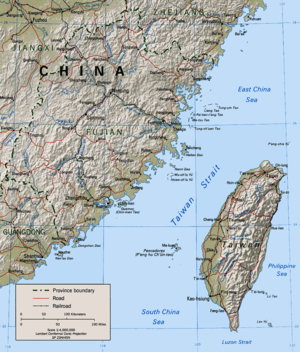Wade–Giles
In mainland China, Wade–Giles has been mostly replaced by Hanyu Pinyin, which was officially adopted in 1958, with exceptions for the romanized forms of some of the most commonly used names of locations and persons, and other proper nouns.Wade published Yü-yen Tzŭ-erh Chi (語言自邇集; 语言自迩集)[2] in 1867, the first textbook on the Beijing dialect of Mandarin in English,[3] which became the basis for the system later known as Wade–Giles.[4] Taiwan used Wade–Giles for decades as the de facto standard, co-existing with several official romanizations in succession, namely, Gwoyeu Romatzyh (1928), Mandarin Phonetic Symbols II (1986), and Tongyong Pinyin (2000).Giles's A Chinese–English Dictionary also includes the finals -io (in yo, chio, chʻio, hsio, lio and nio) and -üo (in chüo, chʻüo, hsüo, lüo and nüo), both of which are pronounced -üeh in modern Standard Chinese: yüeh, chüeh, chʻüeh, hsüeh, lüeh and nüeh.Thomas Wade and others used the spiritus asper (ʽ or ʻ), borrowed from the polytonic orthography of the Ancient Greek language.POJ, Legge romanization, Simplified Wade, and EFEO Chinese transcription use the letter ⟨h⟩ instead of an apostrophe-like character to indicate aspiration.However, if the apostrophe-like characters are kept, the system reveals a symmetry that leaves no overlap: Like Yale and Mandarin Phonetic Symbols II, Wade–Giles renders the two types of syllabic consonant (simplified Chinese: 空韵; traditional Chinese: 空韻; Wade–Giles: kʻung1-yün4; Hànyǔ Pīnyīn: kōngyùn) differently: These finals are both written as -ih in Tongyòng Pinyin, as -i in Hànyǔ Pīnyīn (hence distinguishable only by the initial from [i] as in li), and as -y in Gwoyeu Romatzyh and Simplified Wade.What is pronounced in vernacular Peking dialect as a close-mid back unrounded vowel [ɤ] is written usually as ê, but sometimes as o, depending on historical pronunciation (at the time Wade–Giles was developed).The Romanization system used in the 1943 edition of Mathews' Chinese–English Dictionary differs from Wade–Giles in the following ways:[7] Examples of Wade–Giles derived English language terminology:
AlphabetThomas WadeHerbert GilesMandarin ChineseISO 15924ChineseStandard MandarinHanyu PinyinBopomofoGwoyeu RomatzyhTongyong PinyinYale Romanizationphonetic transcriptionsInternational Phonetic AlphabetTaiwan Straitromanization systemThomas Francis WadeA Chinese–English DictionaryNanjing dialectBeijing dialectpostal romanizationsmainland ChinaKaohsiungMatsu IslandsChiang Ching-kuoUniversity of CambridgeMandarinLionel GilesMandarin Phonetic Symbols IIKuomintangMa Ying-jeouTsai Ing-wenDemocratic Progressive PartyChinese soundLabialDentalAlveolarRetroflexAlveolo-palatalPlosiveUnaspiratedAspiratedpʻ [pʰ]tʻ [tʰ]kʻ [kʰ]Affricatets [ts]ch [ʈʂ]ch [tɕ]tsʻ [tsʰ]chʻ [ʈʂʰ]chʻ [tɕʰ]Fricativesh [ʂ]hs [ɕ]Liquidj [ɻ~ʐ]Standard Chineseunaspirated-aspiratedstop consonantapostrophespiritus asperpolytonic orthographyAncient Greekquotation markbacktickChinese varietiesvoicedShanghaineseMin NanPe̍h-ōe-jīLegge romanizationSimplified WadeEFEO Chinese transcriptionrevisions of the 1970sMcCune–ReischauerKoreanISO 11940syllabic consonantsimplified Chinesetraditional ChineseHànyǔ PīnyīnsibilantsTongyòng PinyinZhùyīn (Bōpōmōfō)MPS IIZhùyīnclose-mid back unrounded vowelPīnyīninterrogativeneutral tonehyphenscapitalizedproper nounoverseasTaiwanese peoplegiven namesChinese namesFrenchallophonesumlautfront vowelback vowelthere iskung1-fuPinyinChinese charactersMathews' Chinese–English DictionarydiacriticInternational Phonetic Alphabet before the revisions of the 1970sWade–Giles tableTzu Chi UniversityLienchiang CountyPingtung CountyComparison of Chinese transcription systemsDaoism–Taoism romanization issueRomanization of ChineseCyrillization of ChineseLibrary of CongressArmy Map ServiceChinese languageSinitic languagesMajor linguistic groupsNortheasternChangchunHarbin